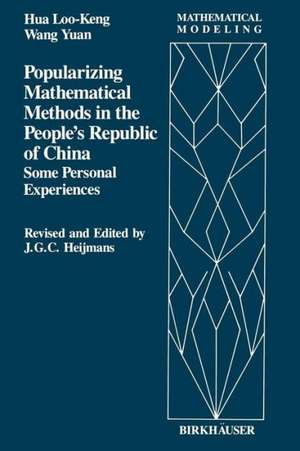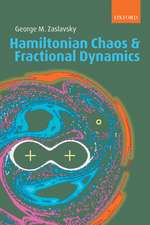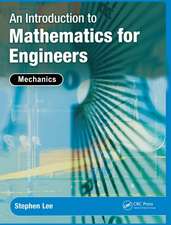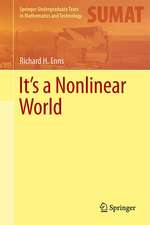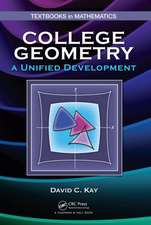Popularizing Mathematical Methods in the People’s Republic of China: Some Personal Experiences: Mathematical Modeling, cartea 2
Autor L.K. Hua, Wangen Limba Engleză Paperback – 13 mar 2012
Preț: 384.70 lei
Nou
Puncte Express: 577
Preț estimativ în valută:
73.62€ • 76.58$ • 60.78£
73.62€ • 76.58$ • 60.78£
Carte tipărită la comandă
Livrare economică 14-28 aprilie
Preluare comenzi: 021 569.72.76
Specificații
ISBN-13: 9781468467598
ISBN-10: 146846759X
Pagini: 236
Ilustrații: XXII, 209 p.
Dimensiuni: 155 x 235 x 12 mm
Greutate: 0.34 kg
Ediția:Softcover reprint of the original 1st ed. 1989
Editura: Birkhäuser Boston
Colecția Birkhäuser
Seria Mathematical Modeling
Locul publicării:Boston, MA, United States
ISBN-10: 146846759X
Pagini: 236
Ilustrații: XXII, 209 p.
Dimensiuni: 155 x 235 x 12 mm
Greutate: 0.34 kg
Ediția:Softcover reprint of the original 1st ed. 1989
Editura: Birkhäuser Boston
Colecția Birkhäuser
Seria Mathematical Modeling
Locul publicării:Boston, MA, United States
Public țintă
ResearchCuprins
0 Introduction.- § 0.1 Three principles.- § 0.2 Looking for problems in the literature.- § 0.3 Looking for problems in the workshop.- § 0.4 Optimum seeking methods (O.S.M).- § 0.5 The Fibonacci search.- § 0.6 The golden number and numerical integration.- § 0.7 Overall planning methods.- § 0.8 On the use of statistics.- § 0.9 Concluding remarks.- 1 On the Calculation of Mineral Reserves and Hillside Areas on Contour Maps.- § 1.1 Introduction.- § 1.2 Calculation of mineral reserves.- § 1.3 Calculation of hillside areas.- References.- 2 The Meshing Gear-Pair Problem.- § 2.1 Introduction.- § 2.2 Simple continued fractions.- § 2.3 Farey series.- § 2.4 An algorithm for the problem.- § 2.5 The solution to the meshing gear-pair problem.- References.- 3 Optimum Seeking Methods (single variable).- § 3.1 Introduction.- § 3.2 Unimodal functions.- § 3.3 Method of trials by shifting to and fro.- § 3.4 The golden section method.- § 3.5 The proof of Theorem 3.1.- § 3.6 The Fibonacci search.- § 3.7 The proof of Theorem 3.2.- § 3.8 The bisection method.- § 3.9 The parabola method.- References.- 4 Optimum Seeking Methods (several variables).- § 4.1 Introduction.- § 4.2 Unimodal functions (several variables).- § 4.3 The bisection method.- § 4.4 The successive approximation method.- § 4.5 The parallel line method.- § 4.6 The discrete case with two factors.- § 4.7 The equilateral triangle method.- § 4.8 The gradient method.- § 4.9 The paraboloid method.- § 4.10 Convex bodies.- § 4.11 Qie Kuai Fa.- §4.12 The 0–1 variable method.- References.- 5 The Golden Number and Numerical Integration.- § 5.1 Introduction.- § 5.2 Lemmas.- § 5.3 Error estimation for the quadrature formula.- § 5.4 A result for 0 and a lower bound for the quadrature formula.- § 5.5Remarks.- References.- 6 Overall Planning Methods.- § 6.1 Introduction.- § 6.2 Critical Path Method.- § 6.3 Float.- § 6.4 Parallel operations and overlapping operations.- § 6.5 Manpower scheduling.- References.- 7 Program Evaluation and Review Technique (Pert).- § 7.1 Introduction.- § 7.2 Estimation of the probability.- § 7.3 Computation process.- § 7.4 An elementary approach.- § 7.5 Remarks.- References.- 8 Machine Scheduling.- § 8.1 Introduction.- § 8.2 Two-machine problem.- § 8.3 A lemma.- § 8.4 Proof of Theorem 8.1.- References.- 9 The Transportation Problem (Graphical Method).- § 9.1 Introduction.- § 9.2 One cycle.- § 9.3 Proof of Theorem 9.1.- References.- 10 The Transportation Problem (Simplex Method).- § 10.1 Introduction.- § 10.2 Eliminated unknowns and feasible solutions.- § 10.3 Criterion numbers.- § 10.4 A criterion for optimality.- § 10.5 Characteristic numbers.- § 10.6 Substitution.- § 10.7 Linear programming.- References.- 11 The Postman Problem.- § 11.1 Introduction.- § 11.2 Euler paths.- § 11.3 A necessary and sufficient criterion for an optimum solution.- References.
